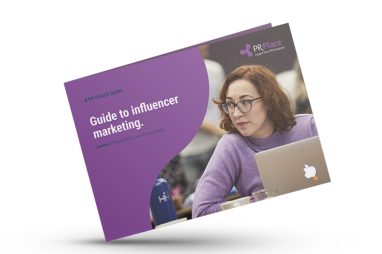Time to jump on the TikTok train?
About the author
Millie Salkeld prepared this article for a CIPR Professional PR Diploma assignment while studying with PR Academy.

Two hours and 29 minutes.

The average daily time that the 4.07 billion social media users across the world spend scrolling, watching, liking, retweeting, sharing and commenting.
And organisations have just seconds between scrolling and swiping to grab users’ attention and deliver their message; in between that funny cat video and friends arguing about the colour of the dress (white and gold right?!).
Whether you are trying to inform the people of Portsmouth when green bin day is or share key public health messages on coronavirus, social media has quickly grown to be a vital part in the public sector communications toolbox over the last few years.
However, it seems every day there is another social media channel popping up (anyone in the mood to BeReal?), so how do public sector communications teams with limited budgets and resources decide which are the best channels to focus on?
Please welcome my argument for why in 2023, it should be TikTok.
Don’t always listen to the tabloids
With more than 1.5 billion users and the ability to go viral with next to no followers (harder than it looks folks but you catch the drift), the short-form video platform has all communications experts hooked.
But unlike Facebook, Twitter and Instagram, where nowadays you will find most organisations, TikTok seems to be a slow burner, particularly for the public sector.
Unlike Facebook, Twitter and Instagram, where nowadays you will find most organisations, TikTok seems to be a slow burner, particularly for the public sector.
Back in 2006 when Facebook launched Facebook Ads, private sector organisations jumped at the first real opportunity to interact with their audiences online.
Fast forward two decades and the private sector seems to be first in line again, ready to try their hand at a new way to engage with the younger generation.
They would be labelled as innovators by E.M Rogers as part of his Diffusion Theory; those who are willing to take risks and are the first to try new ideas that will eventually diffuse into use by all.
The public sector, however, is more risk averse and are more likely to be in the late majority or laggards when it comes to new ideas. Few of them have dipped their toe into the TikTok pool since its explosion in lockdown in 2020.
The tabloid press may hold some responsibility for contributing to this reluctance after their constant criticism of NHS staff doing TikTok dances during their breaks between dealing with waves of Covid.
But a YouGov poll showed that 45% of people supported nurses dancing in their breaks and 41% of people didn’t really care either way.
So maybe public health messages shared to the latest chart topper isn’t the PR disaster that the Daily Mail wants us to believe but instead a useful message carrier to those under 30.
Video content is king
What multibillionaire Bill Gates wrote in 1996 still rings true – content is king.
Planning varied and high quality social media content is integral to ensuring channels are helping to strategically support the aims of any organisation.
And videos have become key to that content strategy, not just for analytics but for real impact.
The cone of experience model by Edgar Dale shows that on average people remember 10% of what they read after two weeks but if they see it and hear it, that shoots up to 50% – a point on the scorecard for resourcing visual content.
According to a study by Kings College London, nearly half the public also say they think their attention span has gotten shorter, so with the average TikTok lasting 21 to 34 seconds the audience may just stick around to see and hear what you have to say.
To paraphrase Mr Gates, short form video with a clear message is king, and that makes TikTok its loyal subject.
Keep calm and be funny
The three main reasons that people share content on social media is because it is new, interesting or funny.
Humour tends to be a pillar that organisations (both public and private) can shy away from but in recent years social media has shown its value in giving organisations the chance to provide lols* and be more relatable to its audience.
*laugh out loud moments
Budget airline Ryanair is among those soaring on TikTok with nearly two million followers thanks to its ‘‘plane face’ videos, clapbacks to users and jibes at Downing Street for its parties.
But does making fun of customers really increase how many people are likely to choose their flights?
Using humour has been shown in studies to increase knowledge retention in students when used by their teachers and increase people’s willingness to change their attitudes and behaviours.
Both concepts may help with explaining the communications value of sassy comebacks and hopping on viral humorous trends.
Michael Corcoran, Head of Social at Ryanair, told ContentCal last year that while they are still looking at how to make social media measurable in terms of sales conversions, anecdotally Gen-Z have been buying tickets so they can video themselves next to the ‘plane face’.
So Ryanair seems to have nailed their social media angle; the younger generation looking for a cheap deal who also enjoy seeing their peers get roasted by a multi-million pound company.
Clapping back to comments (though however much all communication professionals sometimes want to) is perhaps not a water-tight strategy for an NHS trust or borough council but the success private sector organisations have seen from acting a little less corporate and a lot more funny does highlight the importance of injecting a little fun into content to get engagement and traction from your audience.
Success for the first explorers
One such brave public sector organisation who has made the TikTok leap is South Wales Police.
The force has been using the app for reputation, recruitment and public safety messages, hitting more than 213,000 followers, grabbing 2.4 million likes and bagging themselves the award for best social media account at the Comms2point0 UnAwards.
Top most viewed video? Coming in at 22.4 million views, it shows a variety of different jobs in the force set to an iconic We Will Rock You beat.
@swpolice One team, working together, #KeepingSouthWalesSafe Un tîm, yn cydweithio, #CadwDeCymruYnDdiogel . #Policing #Teamwork #Police #Plismona #GwaithTîm #Heddlu ♬ We Will Rock You Wind Rhythm – TMG
With more than 80% of users on TikTok aged 16 to 34 years old, its current viral popularity gives organisations a chance to engage with the younger demographic who have moved off Facebook.
Instagram is still getting a look in from Gen Z for the moment and visual content can be recycled for Instagram Reels – two birds, one video.
Over the summer, Redbridge Council announced their new Chief Executive complete to the Love Island bombshell theme tune that was trending.
The result?
More than 84,000 views and a chance to demonstrate that public sector workers in politics are humans too.
@redbridgecouncil #loveislandtrend #loveisland #fy #fyp #foryou #foryoupage ♬ Hot New Bombshell – grace
Undoubtedly for councils trying to get more young people involved in local politics and voting for their future, TikTok may see them hitting their strategic targets quicker than they can say sponsored Facebook Ad.
What next?
In a paper on social media, Professor Olivier Serrat from the Chicago School of Professional Psychology said that public sector organisations were inactives on the social technographics ladder, as developed by Forrester Research.
The inactive group comes at the bottom of the ladder and are described as those not even on social media.
While PR expert Heather Yaxley has seen a pattern of slow adoption of the latest technology within the PR world, hundreds of public sector communicators, currently creating, editing and scheduling social media content would strongly disagree with Serrat’s conclusion.
We aren’t held back by ambition but budget, resource, apprehension from senior leaders and permission from IT governance (don’t even get me started).
We aren’t held back by ambition but budget, resource, apprehension from senior leaders and permission from IT governance
But with the overwhelming data analytics, success seen by private sector companies and the chance to show organisations as a bit more human, putting TikTok firmly on the table at any public sector organisation in 2023 needs to go viral.
Let’s make those two hours and 29 minutes count.


